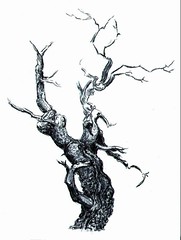An artist's workspace, insofar as he or she has anything to say about its location, contents, and arrangement, tells an awful lot about him or her. It may also give us ideas about some things we may want to try ourselves. (It also may make us quite jealous.) It's always interesting, therefore, to observe the conditions under which different artists do their drawing or painting (or whatever they do).
Now and then I'll be featuring the workspaces of some friends of mine. I'm beginning today with Brian McGurgan's art workspace in his apartment in a large city on the east coast of the United States.
I'll let Brian do most of the "talking."

"The windows visible in the photo above face east and are unobstructed so we get very strong morning light on clear and partly cloudy days. There are two windows on this side of the room and two that face south, although the trees from the park block out some of the light - especially in spring, summer, and fall."
Brian works with Unison Pastels (he has virtually every color they make), Conté Crayons, and Conté Pastel Pencils. He also paints with watercolors.

I'll let Brian speak for himself again:
"My workspace takes up a little more than 1/6th of the space in the room, and we also have a computer desk here for my wife's computer and printer, a couple of bookshelves, several large ficus trees (7 feet and taller), my orange tree and other plants, a clavinova, and an area with my meditation things set up on a small cabinet.
"My work area stays set up all of the time but the pastels are usually covered (you can see the box lids stacked in the lowest shelf on the kitchen cart). I've been using small boxes with little pieces of Conté crayons, even when working indoors, and have a Roz box with my stockpile of at least two sticks in every color stowed to the right of my drawing table. The plastic drawers beneath the drawing table contain supplies - the top has various miscellaneous extra pastels, pastel pencils, Conté crayons, paintbrushes, etc., and the bottom drawer contains pads and blocks of pastel and watercolor paper.
"Larger pads of paper and individual sheets of handmade papers are stored in a stack on top of the plastic drawers. The largest sheets of handmade paper are stored in flat cardboard and craft paper and are leaning upright against the wall behind the drawing table.
"You can see that all of my soft pastel sets are out and open. I sometimes shuffle them around - for example, putting the grays, browns and other neutrals on the top of the kitchen cart and moving the boxes with the primary and secondary colors below when working on a drawing with more subdued color. I keep the smaller boxes of orange, dark, light, and other colors (that are on the drawing table next to the table top easel) out even when I'm working on drawings where it is unlikely that I'll need them since I may need a touch of these colors from time to time and they are also nice to look at.
"The drawer inside the table top easel contains erasers, stumps, chamois, sharpeners, and vine charcoal. I keep a couple of cans of fixative nearby (on top of the Roz box to the right of the plastic drawers).
"Beneath the small folding stand that the pastel pencils and Conté crayons are on is an air cleaner. I run this at a low speed while I draw and turn it up stronger after spraying with fixative (I usually leave the room for thirty minutes or so after spraying and prefer to do this outdoors when the weather is nice). Until recently, I hadn't been using much fixative but have been working with it more these days to allow for better layering and nicer textures in my work.
"The bookshelf has a shelf dedicated to books on individual artists or sets of paintings or drawings around a given theme. Another shelf holds art technique books and language-learning texts (for Japanese and French). One shelf holds National Geographic magazine, Rosetta Stone software and Berlitz tapes (both for French). The top two shelves have some of my wife's books and decorations on them.
"I have several drawing boards that I rotate use of (or leave drawings on that I have grown tired of working with but expect to continue on at some point). At times, I'll set up my field easel indoors in the area in front of my workspace, especially if drawing plants from life (the orange tree and ficus trees are in the area to the right of my chair in the first photo) or when drawing the view out the window.
"The space works pretty well for the things I'm doing now. I would like to get some kind of foam mat for the floor, though. The wood floor is easy to clean but is brutal on pastels when they get dropped."
Not only is Brian's workspace beautiful, well-stocked, and comfortable looking, but he has done a wonderful job of describing it. I have no more words to add...except that I am very impressed!
To subscribe to the Thinking About Art Monthly Newsletter, see near bottom of page.










